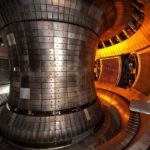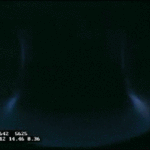Tokamaks: the future of fusion energy
Fusion is the energy that powers our Sun and other stars. It has been a goal of scientists around the world to harness this process by which the stars “burn” hydrogen into helium (i.e. nuclear fusion) for energy production on Earth since it was discovered in the 1940′s.
Nuclear fusion is the process by which light nuclei fuse together to create a single, heavier nucleus and release energy. Given the correct conditions (such as those found in plasma), nuclei of light elements can smash into each other with enough energy to undergo fusion. The “easiest” (most energetically favorable) fusion reaction occurs between the hydrogen isotopes deuterium and tritium. When the nucleus of a deuterium atom crashes into the nucleus of a tritium atom with sufficient energy, a fusion reaction occurs and a huge amount of energy is released, 17.6 million electron volts to be exact.
Why fusion? To put this in terms of energy that we all experience; fusion generates more energy per reaction than any other energy source. A single gram of deuterium/tritium fusion fuel can generate 350 million kJ of energy, nearly 10 million times more energy than from the same amount of fossil fuel!
Fusion power has the potential to provide sufficient energy to satisfy mounting demand, and to do so sustainably, with a relatively small impact on the environment. Nuclear fusion has many potential attractions. Firstly, its hydrogen isotope fuels are relatively abundant – one of the necessary isotopes, deuterium, can be extracted from seawater, while the other fuel, tritium, would be bred from a lithium blanket using neutrons produced in the fusion reaction itself. Furthermore, a fusion reactor would produce virtually no CO2 or atmospheric pollutants, and its other radioactive waste products would be very short-lived compared to those produced by conventional nuclear reactors.
Fusion reactions require so much energy that they must occur with the hydrogen isotopes in this plasma state. Plasma makes up all of the stars, and is the most common form of matter in the visible universe. Since plasmas are made of charged particles every particle can interact with every other particle, even over very long distances. The fact that 99% of the universe is made of plasmas makes studying them very important if we are to understand how the universe works.
How do we create fusion in a laboratory? This is where tokamaks come in. In order for nuclear fusion to occur, the nuclei inside of the plasma must first be extremely hot, like in a star. Unfortunately, no material on Earth can withstand these temperatures so in order to contain a plasma with such high temperatures, we have to be creative. One clever solution is to create a magnetic “bottle” using large magnet coils to capture the plasma and suspend it away from the container’s surfaces. The plasma follows along the magnetic field, suspended away from the walls. This complex combination of magnets used to confine the plasma and the chamber where the plasma is held is known as a tokamak. Tokamaks have a toroidal shape (i.e. they are shaped like a donut) so they have no open ends for plasma to escape. Tokamaks, like the ASDEX Upgrade (pictured above), create and contain the hottest materials in the solar system. The aim of ASDEX Upgrade, the “Axially Symmetric Divertor Experiment”, is to prepare the physics base for ITER.
ITER (International Thermonuclear Experimental Reactor and Latin for “the way” or “the road”) is an international nuclear fusion research and engineering project, which is currently building the world’s largest experimental tokamak nuclear fusion reactor. The ITER project aims to make the long-awaited transition from experimental studies of plasma physics to full-scale electricity-producing fusion power plants.
Further readings:


